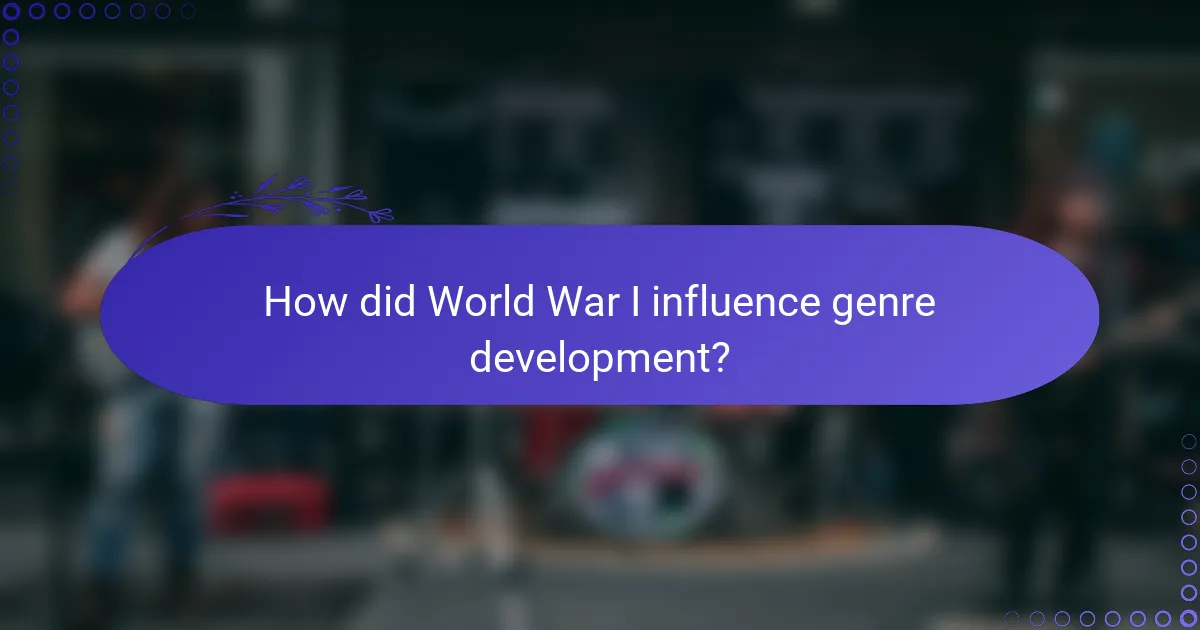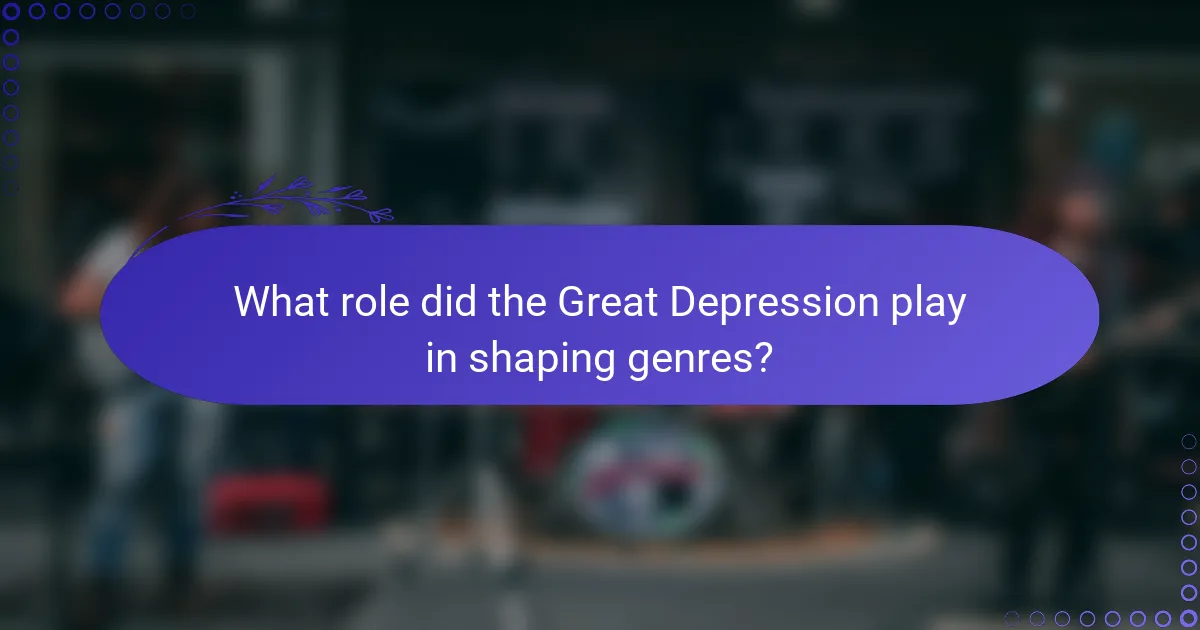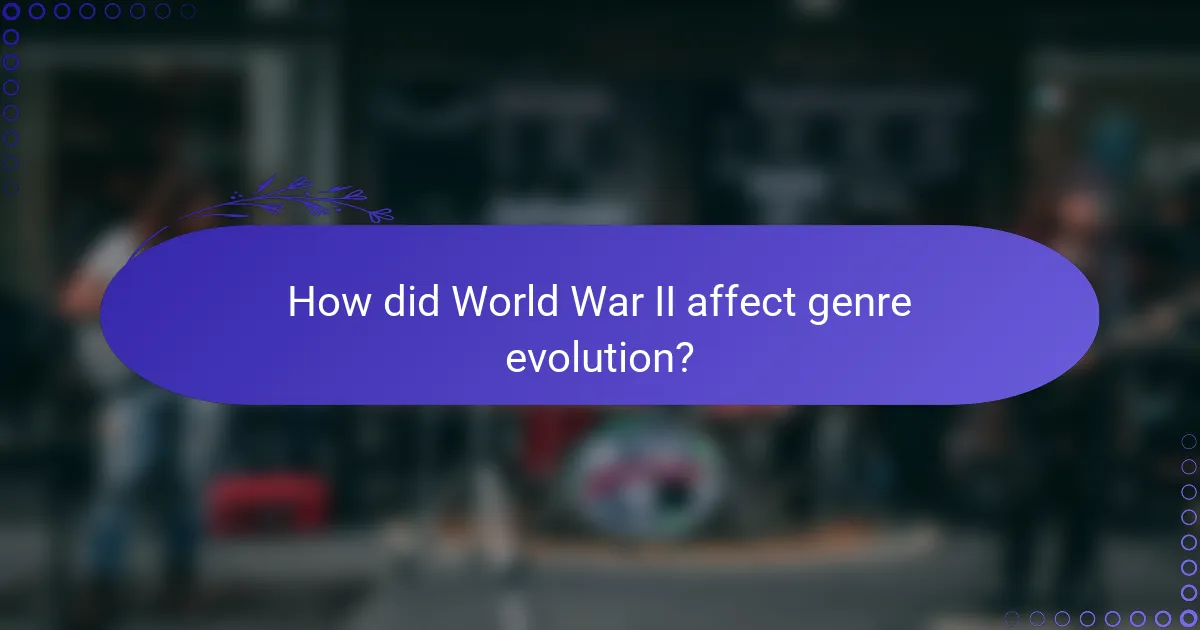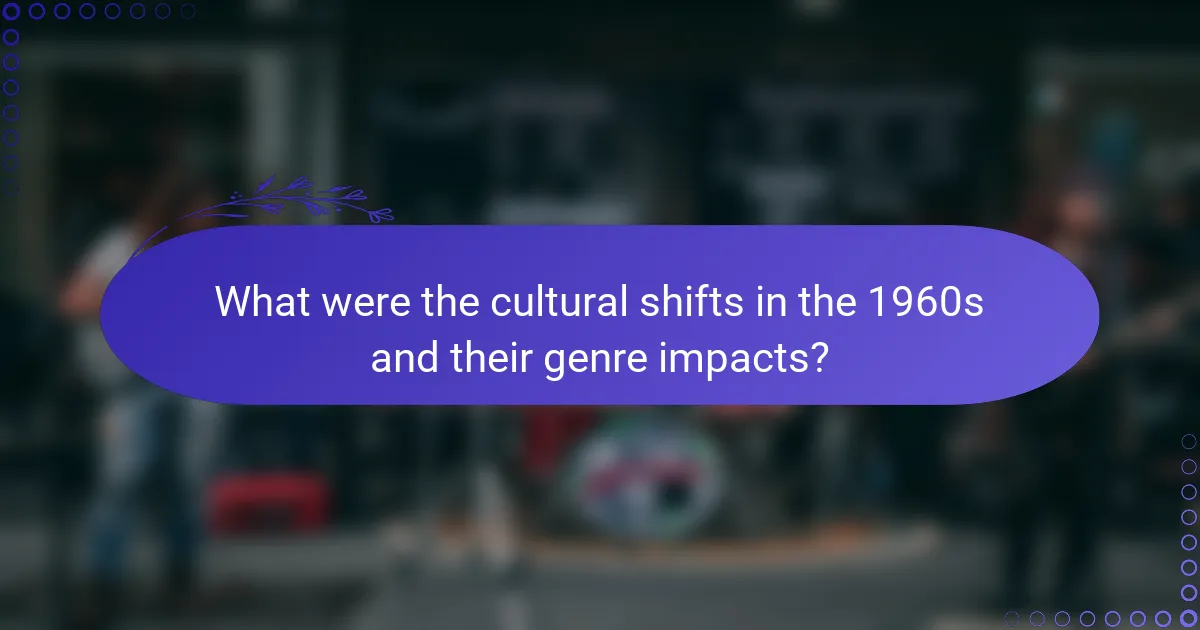The 20th century was marked by transformative events that profoundly impacted genre development across various artistic mediums. From the disillusionment following World War I to the societal struggles during the Great Depression and the narrative shifts prompted by World War II, these events catalyzed the emergence of new genres and the evolution of existing ones. Artists and writers responded to the complexities of their times, exploring themes of trauma, resilience, and social justice, ultimately reshaping the landscape of literature, film, and music.

How did World War I influence genre development?
World War I significantly shaped genre development by introducing themes of disillusionment and trauma, which permeated various forms of art and literature. The war’s impact led to the emergence of new genres and a transformation of existing ones, reflecting the complexities of human experience during and after the conflict.
Emergence of modernist literature
The aftermath of World War I gave rise to modernist literature, characterized by a break from traditional narrative forms and a focus on fragmented realities. Writers like T.S. Eliot and Virginia Woolf explored themes of alienation and the search for meaning in a chaotic world, often employing stream-of-consciousness techniques.
This genre challenged readers to engage with complex ideas and unconventional structures, reflecting the disorientation felt in post-war society. Modernist literature often questioned established norms and sought to capture the essence of contemporary life through innovative styles.
Rise of war films
World War I catalyzed the rise of war films, which began to depict the realities of combat and its psychological effects on soldiers. Early films like “All Quiet on the Western Front” highlighted the brutalities of war, moving away from glorified portrayals to more realistic narratives that resonated with audiences.
The genre evolved to include various sub-genres, such as anti-war films and biographical dramas, which further explored the human cost of conflict. This shift in representation allowed filmmakers to address the complexities of war, fostering a deeper understanding of its impact on individuals and society.
Impact on science fiction
The experiences of World War I influenced the evolution of science fiction, as writers began to explore themes of technology and its consequences. The war showcased the destructive potential of advanced weaponry, prompting authors to speculate on future societies shaped by technological advancements.
Works like H.G. Wells’ “The War of the Worlds” reflected anxieties about invasion and the unknown, while also addressing the moral implications of scientific progress. This genre became a platform for examining societal fears and aspirations, allowing for critical discussions about humanity’s future in a rapidly changing world.

What role did the Great Depression play in shaping genres?
The Great Depression significantly influenced the development of various artistic genres, particularly by reflecting societal struggles and changes. This economic crisis prompted creators to explore themes of hardship, resilience, and social justice, leading to the emergence of new styles and movements in literature, film, and musical theatre.
Growth of social realism in literature
Social realism emerged as a prominent literary genre during the Great Depression, focusing on the everyday lives of ordinary people facing economic hardships. Authors like John Steinbeck and Richard Wright depicted the struggles of the working class, often highlighting issues such as poverty, discrimination, and social injustice.
This genre aimed to raise awareness and provoke thought, using realistic narratives to inspire empathy and action among readers. Works like “The Grapes of Wrath” and “Native Son” became emblematic of the era, illustrating the profound impact of economic despair on human lives.
Development of film noir
The Great Depression also gave rise to film noir, a genre characterized by its dark themes, moral ambiguity, and complex characters. As audiences sought escapism from their grim realities, filmmakers created stories that reflected the anxieties of the time, often featuring protagonists caught in a web of crime and corruption.
Classic films such as “The Maltese Falcon” and “Double Indemnity” exemplified this genre, utilizing shadowy cinematography and intricate plots to convey a sense of hopelessness and disillusionment. The stylistic elements of film noir continue to influence modern cinema, showcasing the lasting impact of this era.
Influence on musical theatre
The Great Depression reshaped musical theatre by introducing more serious themes and socially conscious narratives. Productions began to reflect the struggles of everyday life, moving away from purely escapist entertainment to include stories that resonated with the audience’s experiences during tough economic times.
Shows like “Porgy and Bess” and “Cabaret” tackled issues such as poverty, racial inequality, and political unrest, blending music with poignant storytelling. This shift not only enriched the genre but also paved the way for future musicals to address complex social issues, making them relevant and impactful.

How did World War II affect genre evolution?
World War II significantly influenced the evolution of various film and literary genres, shaping narratives and themes to reflect the societal changes and sentiments of the time. The war prompted the rise of propaganda, transformed detective fiction, and led to a surge in post-war literature that explored the complexities of human experience in a changed world.
Rise of propaganda films
The onset of World War II saw a marked increase in propaganda films, which were designed to boost morale and promote nationalistic sentiments. Governments, particularly in the United States and the United Kingdom, produced films that emphasized heroism, unity, and the fight against tyranny.
These films often featured exaggerated portrayals of the enemy and idealized depictions of soldiers and civilians contributing to the war effort. Iconic examples include “Why We Fight,” a series of films commissioned by the U.S. government, which aimed to educate and motivate the American public about the war’s significance.
Impact on detective fiction
World War II brought a shift in detective fiction, moving away from traditional whodunits to more complex narratives that reflected the moral ambiguities of the time. Authors began to incorporate themes of betrayal, espionage, and the psychological toll of war, leading to a darker and more nuanced portrayal of crime and justice.
Writers like Raymond Chandler and Dashiell Hammett adapted their styles to include elements of realism, showcasing flawed characters and morally gray situations. This evolution not only enriched the genre but also paved the way for the hard-boiled detective archetype that remains influential today.
Growth of post-war literature
In the aftermath of World War II, literature experienced a significant transformation, with many authors grappling with the war’s impact on society and the individual. This period saw the emergence of existential themes, as writers sought to make sense of human suffering and the absurdity of life in a post-war context.
Notable figures such as Kurt Vonnegut and Joseph Heller used satire and dark humor to critique societal norms and the consequences of war. The growth of post-war literature not only reflected the disillusionment of the era but also laid the groundwork for future literary movements, including postmodernism.

What were the cultural shifts in the 1960s and their genre impacts?
The 1960s were marked by significant cultural shifts that greatly influenced various artistic genres. Movements such as counterculture, civil rights, and anti-war protests shaped music, literature, and film, leading to new forms of expression and thematic exploration.
Emergence of counterculture in music
The counterculture movement of the 1960s gave rise to new musical genres, particularly rock and folk, which often carried messages of rebellion and social change. Artists like Bob Dylan and The Beatles used their platforms to address issues such as peace, love, and civil rights, resonating with a generation seeking change.
This era saw the birth of subgenres like psychedelic rock, characterized by experimental sounds and lyrics that reflected the era’s exploration of consciousness and alternative lifestyles. Festivals like Woodstock became iconic, symbolizing the unity and spirit of the counterculture movement.
Development of dystopian fiction
The 1960s also witnessed a surge in dystopian fiction, reflecting societal anxieties about war, technology, and government control. Authors like George Orwell and Kurt Vonnegut explored themes of totalitarianism and existential despair, prompting readers to question the direction of society.
This genre’s popularity can be attributed to the Cold War climate, which fueled fears of nuclear annihilation and loss of individual freedoms. Dystopian narratives often served as cautionary tales, encouraging critical thinking about contemporary issues.
Influence on experimental film
Experimental film emerged as a powerful medium in the 1960s, challenging traditional narrative structures and exploring avant-garde techniques. Filmmakers like Andy Warhol and Stan Brakhage pushed boundaries, using unconventional methods to provoke thought and evoke emotional responses.

How did the Cold War shape genre narratives?
The Cold War significantly influenced genre narratives by introducing themes of espionage, technological advancement, and political intrigue. These elements became central to various genres, reflecting societal fears and tensions during this period.
Rise of spy thrillers
The Cold War sparked a surge in spy thrillers, as audiences were captivated by tales of espionage and covert operations. This genre often featured protagonists who were intelligence agents navigating a world of deception and betrayal, mirroring real-life geopolitical tensions.
Notable works, such as John le Carré’s “The Spy Who Came in from the Cold,” exemplified the complexity of espionage, focusing on moral ambiguity rather than clear-cut heroes and villains. The popularity of these narratives led to a proliferation of films and novels that explored the darker side of intelligence work.
Impact on science fiction themes
Science fiction during the Cold War often reflected anxieties about nuclear war and technological advancements. Themes of dystopia and the potential consequences of unchecked scientific progress became prevalent, as writers sought to explore the implications of a rapidly changing world.
Development of political dramas
The Cold War also led to the emergence of political dramas that scrutinized government actions and international relations. These narratives often highlighted the complexities of diplomacy and the moral dilemmas faced by leaders during times of conflict.
